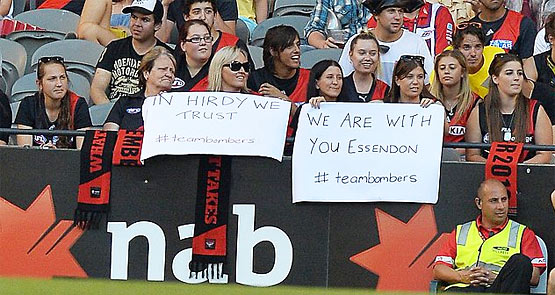
As Dean “the weapon” Robinson’s paid interview with commentator Luke Darcy went to air on the Seven Network last night, senior journos from the world’s most over-analysed professional football code were busy hammering their keyboards to fill today’s papers with rivers of ball-tearing reportage.
In the billion-dollar AFL media bubble rimmed by huge egos, hero worship and beer ads, what gets written on the Essendon supplements scandal matters to a majority of Melburnians. But the coverage of the drama, reliant mostly on leaks from vested interests and “off-the-record” briefings, has led many readers to seriously doubt the sports media’s role as an impartial umpire.
The media orgy in the six months since Bombers coach James Hird and former chairman David Evans “dobbed themselves in” to the Australian Sports Anti-Doping Authority has split into two camps: an anti-Hird brigade centred on veteran Age football writer Caroline Wilson and Australian commentator Patrick Smith; and pro-Hird Herald Sun hack Mark “Robbo” Robinson and his merry band of Southbank scribes on the other.
Robbo has been keen to blame the fracas on dubious “sports scientist” Steve Dank and fitness buff Robinson to build a firewall around Windy Hill’s crown jewels. At The Oz, Smith has reported on multiple occasions that Hird “decided” to stand down before the round three game against Fremantle until ASADA’s investigation was complete, but later “changed his mind”. However, the Hird camp says he’s never put the claims to the coach himself.
He hasn’t been alone in his attacks. In April, Wilson brazenly called for Hird to sack himself. The problem, insiders say, is that all three reporters have hardly been shy about their views in comment pieces and myriad TV appearances.
In a neat symmetry, Essendon’s internal war pitting Evans against Hird has been bookended by spinners wedded to opposite sides of politics.
Liberal Party operative Ian Hanke and (until she quit this week) Essential Media Communications director Liz Lukin have been hard at work protecting their patch and backgrounding heavily against their enemies — in other words, doing their jobs. Last week’s breakdown in the Hird/Evans relationship generated by Hanke and reported by Robinson laid the fissure bare: the Labor and union-linked Lukin had been on the side of Evans and the club, with arch-conservative Hanke rolling out every trick in the book to protect Hird.
Hanke managed to gift Robinson two Herald Sun splashes in successive days reporting differing accounts of a call placed by AFL boss Andrew Demetriou to Evans on February 4. Robinson reported Hird was present at the meeting and that an Essendon “source” (Hird, according to Wilson) had told him Demetriou had tipped off Evans that the club was being targeted by the Australian Crime Commission. Demetriou had been briefed the previous week by the ACC and had signed a confidentiality clause — disclosing the detail of ACC briefings is a criminal offence.
That was followed up on Monday — again on the Hun‘s front page — by exclusive letters leaked from the Hird camp slamming Demetriou for allegedly revealing details of the ASADA investigation publicly. Hanke, who confirmed to Crikey the strategy was his, was effectively calling Demetriou and Evans liars on the front page of Australia’s highest circulation daily newspaper. Evans stood down after suffering a “physical breakdown” after Friday night’s loss to Hawthorn.
Despite only meeting once on an ABC Radio spin-doctors’ segment, Lukin and Hanke’s relationship stretches to the 1998 waterfront dispute, where Lukin was spinning for the Maritime Union of Australia and Hanke was working for then-industrial relations minister Peter Reith. They butted heads again during the 2004 WorkChoices barney, where Lukin advised the Australian Council of Trade Unions as Hanke spun for workplace relations minister Kevin Andrews (on one occasion producing a memorable list of ALP national conference delegates and explaining their links to the labour movement).
Lukin, unlike Hanke, has experience in footy, representing the West Coast Eagles during the Ben Cousins ice saga, and representing former AFL commissioner Wayne Jackson and for AFL Players Association chief Matt Finnis during bitter enterprise bargaining negotiations in 2011.
And then there’s the hulking media team working for the AFL headed by hard arse communications tsar Patrick Keane. Their job is to protect the boss and, critics say, send anti-Hird stories to whoever will take them.
“It’s not enough to just muddy the waters. If you’re going to poke that bear, you better not go to a gunfight carrying a spoon.”
Lawyers also loom large: Ashurst partner Steven Amendola is acting for Hird, who famously featured in a 2001 Ross Coulthart Sunday profile as a key anti-union adviser in the O’Connor meatworks dispute. Amendola was drafted in by Reith after a meeting with O’Connor management in an attempt to smash the meatworkers union. Lukin, as it happens, was spinning for the union.
And after Evans’s shock resignation, the Bombers quickly tapped ex-Toll Holdings millionaire boss Paul Little, whose former firm is not exactly a fan of the labour movement either.
A source close to Lukin says the divide between Hanke’s “hard and tough” Hird firewall and Lukin’s “softly softly” stance aimed at preserving club unity and maintaining a relationship with Demetriou is a false dichotomy and fundamentally misreads the terrain. “After you put on the ‘let’s attack Andrew Demetriou’ line and call him a liar,” they said, “what would be your next strategic step after that?
“There’s not a winner and loser in this, Essendon can’t take their bat and ball and play in another league. So it’s all very well to say ‘let’s put James Hird before the interests of the whole club’ but you have to actually have a strategy. It’s not enough to just muddy the waters. If you’re going to poke that bear, you better not go to a gunfight carrying a spoon.”
And, of course, it is Demetriou who may end up sitting in judgement on the Bombers’ future on the AFL Commission, notwithstanding the raft of court cases that are sure to follow the expected release of ASADA’s report into the club next week.
There has also been concern about the amount of material, mostly text messages, sourced directly from Dank and reported as exclusives. Crikey understands Dank speaks regularly to Robinson, the ABC’s Gerard Whateley, The Age‘s Nick McKenzie, ABC reporter Caro Meldrum-Hanna and Channel Nine’s Danny Weidler. This week 7.30 ran a full item based around Dank’s texts.
McKenzie and reporting partner Richard Baker have taken their cues from sources scattered across the spectrum, producing a raft of exclusives related to the supposedly secret ASADA probe, including yesterday’s splash reporting on documents seized from Bombers HQ.
But the sports journos — who also produce regular comment pieces and go on TV shows that make their biases crystal clear — have let rip. Wilson in particular has an eye for a scalp and isn’t afraid to ratchet up the rhetoric if she thinks the situation demands it. Readers need only revisit her cracking and comprehensive 1991 Sunday Age takedown of Piers Akerman to see how poisonous her pen can become.
It’s worth recalling how the drugs scandal came about. In December and January lots of people in the football world talking about the impact of illicit substances in sport and the police were busy backgrounding journalists. Collingwood chief Garry Pert had come out at the end of November, calling recreational drugs the AFL’s “biggest problem”. The league called a drugs summit for the end of January and the air was thick with intrigue.
On February 5, the day after the Demetriou call, the Bombers held a conference to offer the club up to ASADA. Hird professed shock that he was sitting in the conference, believing he had done nothing wrong. Lukin was called in to assist after Evans had received multiple calls from journalists including Crocmedia operative and Footy Show sleuth Damian Barrett. Barrett had interviewed delisted Bombers forward Kyle Reimers, who claimed the club’s 2012 supplements program was skirting “close to the edge”.
The next day Crikey revealed that Stephen Dank had visited doctors and pharmacists at the centre of the dispute, and the day after that the ACC held a blockbuster press conference in Canberra with the chiefs of all major professional sports, producing reams of “darkest day” headlines.
Fast forward to April 11, when Wilson called for Hird to step down, outlining the divide between Evans and Hird. The next day, April 12, came a front-page exclusive by Robinson under the headline “I was jabbed”, reporting Hird thought he was injected but only with legal amino acids. It came just four days before Hird was scheduled to meet with ASADA to give his side of the story.
On May 1 another pro-Hird Herald Sun story emerged claiming the club was duped by a fake letter from the World Anti-Doping Authority brandished by Dank stating that the regulator had ticked off on the controversial anti-obesity drug at the centre of the scandal, AOD 9604. Then, on May 6, Ziggy Switkowski handed his internal report into the club, detailing a “pharmacologically experimental environment”.
Ten weeks later, on July 17, Wilson — citing “sources close to the joint investigation by ASADA and the AFL into Essendon” — splashed with allegations that “the AFL warned James Hird in late 2011 to not involve his players in a peptides program”. Hird, wrote Wilson, “faces a lengthy suspension from the game for his key role in instigating the experimental drug program”.
Hird was irate and Essendon released a statement later that day slamming the yarn as factually incorrect and complaining Hird couldn’t respond before ASADA’s investigation was complete. Cue the run of aggressive Hun front pages planted by Hanke, Evans’ and Lukin’s resignations, Little’s appointment and Robinson’s blockbuster interview. Whatever ASADA dishes up next week, the Bombers, the league and the journalists are unlikely to emerge with clean hands.








“It’s not enough to just muddy the waters. If you’re going to poke that bear, you better not go to a gunfight carrying a spoon.” What?
With all the pressure they exert, to perform, now it’s trial by media again? Remember that rat pack that took to Ratten?
And again, how much are they paying Demetriou, to handle the game like he does, remembering his initial reaction to Eddie Maguire’s King Kong japes?
Is the AFL to sell “beer and soap”?
@ Griffiths Karen
The spoon was being used to muddy the water.
“I’ll be in my basement room with a needle and a spoon”
Keith Richards.
Where is the Minister for Sport.It this business was started without any evidence.
Surely some action could be taken to speed the result.